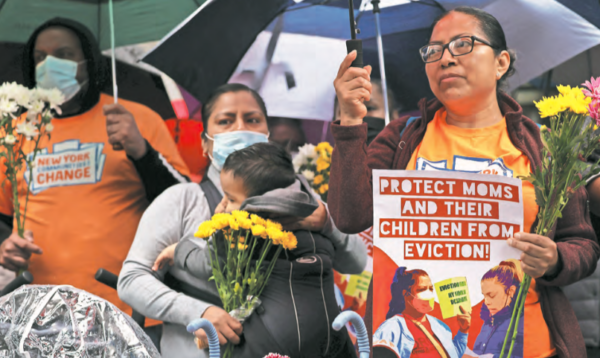
‘I don’t know if I’m gonna have enough for the bills, rent, food’
CARROLL GARDENS — Alice Apolinaris was not celebrating on June 29, the first day of her retirement after 25 years as a public schools paraprofessional.
She burst from her apartment on 3rd Street in Carroll Gardens for a walk, which is how she manages stress. Lately, her anxiety has been growing.
A week earlier, the Rent Guidelines Board (RGB), which regulates rent-stabilized housing in all five boroughs, voted 5-4 to allow the first major rate hikes in eight years. Starting Oct. 1, landlords can raise rents by no more than 3.25% for one-year leases and no more than 5% on two-year leases.

Apolinaris has lived in the same rent-stabilized apartment since the late 1970s. She said she would be OK in the near term because her next lease renewal was set for later next year. Still, the possibility of paying more for rent weighed on her.
“It’s just stressing me out,” she said as she walked down the street. “I don’t know what my pension check is gonna look like. I don’t even know if I’m gonna have enough for the bills, rent, and food.
“This is not a good time to be raising rents.”
New York City created rent stabilization in the late 1960s to help ensure the availability of affordable housing in one of the most expensive cities on the planet. About 1 million homes, approximately half the city’s rental units, are rent-stabilized.
The RGB approved the new rates on June 21. Before the voice vote, pro-tenant protesters frequently shouted over the board members. Similar scenes played out at the board’s earlier public hearings on the rates.
The protestors pressed for no rate increases and argued that working-class families had yet to recover from the economic downturn wrought by the pandemic.
Landlords, meanwhile, argued they needed 6-8% rate hikes to catch up with rising operation costs, taxes, and inflation — all of which kept growing while rates stayed unchanged for eight years.
In the end, neither side got what they wanted.
Tenants, for example, now face as much as 3.25% for one-year leases. The new rates are the biggest since 2013 when one-year leases jumped 4%, while two-year leases grew by 7.5%.
Since the board’s creation in the 1960s, the city’s mayor has appointed its nine members: two representing tenants, two for landlords, and five for the public at large. Static rates since 2013 coincided with the administration of now-former Mayor Bill de Blasio.
Property owner groups complained de Blasio’s appointees wouldn’t budge on unfreezing the rates.
That’s why they sought 6-8% rate hikes, said Robert Ehrlich, one of the two landlord representatives.
“It is a range,” Ehrlich said, “that distributes the high costs of inflation, growing property taxes, rising water rates, and a host of unfunded mandates purported by the City Council disproportionately on property owners instead of the tenant.”
Christina Smyth, the RGB’s other landlord representative, said current rent revenue is not enough to help pay for maintenance to keep buildings safe, clean, and livable. Typical rent-stabilized buildings were built before 1974.
“Whatever we do, nobody wins,” Smyth said. “If we keep rents significantly lower than operating expenses, we are risking the decay of rent-stabilized housing. Our own data shows us that this is starting to happen. We’re seeing less long-term capital investment and maintenance.
“And when you factor in mortgage payments, roughly half of the buildings with more than 80% rent-stabilized housing are in distress. These are the buildings outside of core Manhattan that low-income New Yorkers rely on the most.”
The comments of Ehrlich and Smyth echoed those of Christian Gonzalez-Rivera, one of the “public” board members, who called on the City Council and New York Legislature to ease tax burdens on property owners.
Doing so, he said, would free up more money for building maintenance, which would lower the need to increase rents.
“Rent does not have to be the only source of funds to cover maintenance costs,” Gonzalez-Rivera said. “Our elected officials must step up to create tax abatements for maintenance or to reform a tax structure that unfairly burdens multi-family buildings.”
“You can’t just kick the can over to the RGB,” he added. “That’s not fair to us and certainly not fair to the tenants who have to pay higher and higher rents or the landlords who are forced to choose between paying a higher tax bill or replacing the roof.”
Apolinaris, meanwhile, contemplates an unsettled future. If rent and other costs of living get too high, she might have to move.
But, Apolinaris said she’d prefer to stay. She has deep ties to Carroll Gardens, where she attends nearby St. Paul and St. Agnes Parish on Sackett Street.
“When we first moved in, my daughter was 12 months, and my son was a year and a half,” she said. “My daughter is telling me, ‘Move in with us in Virginia.’ But my son doesn’t want me to move because he lives close by, and he keeps an eye on me.”
“But because I’m rent-stabilized, I really don’t want to leave my apartment,” she added. “I’ve been there for 45 years. My kids grew up in that apartment.”
